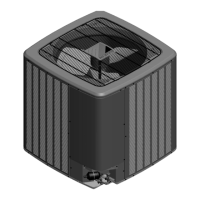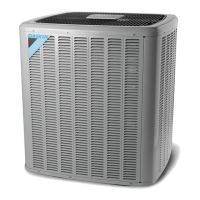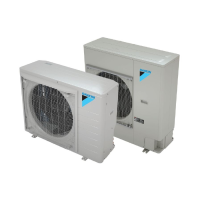Our continuing commitment to quality products may mean a change in specications without notice.
© 2022
19001 Kermier Rd., Waller, TX 77484
www.daikincomfort.com
The following symbols and labels are used throughout this
manual to indicate immediate or potential safety hazards. It
is the owner’s and installer’s responsibility to read and comply
with all safety information and instructions accompanying
these symbols. Failure to heed safety information increases
the risk of personal injury, property damage, and/or product
damage.
Also see “Meanings of Symbols” on page 4.
HEAT PUMP UNIT
DZ9VC HEAT PUMP
INSTALLATION & SERVICE REFERENCE
INSTALLATION INSTRUCTIONS
IOD-4042
12/2022
Index
1
2
2
2
2
3
3
4
7
7
8
8
15
17
21
23
29
32
33
“IMPORTANT – This product has been designed and manufactured to meet ENERGY STAR criteria for energy
eciency when matched with appropriate coil components. However, proper refrigerant charge and proper air
ow are critical to achieve rated capacity and eciency. Installation of this product should follow the manu-
facturer’s refrigerant charging and air ow instructions.
”
WARNING
HIGH VOLTAGE
DISCONNECT ALL POWER BEFORE SERVICING
OR INSTALLING THIS UNIT. MULTIPLE POWER
SOURCES MAY BE PRESENT. FAILURE TO DO SO
MAY CAUSE PROPERTY DAMAGE, PERSONAL
INJURY OR DEATH.
ONLY PERSONNEL THAT HAVE BEEN TRAINED TO INSTALL,
ADJUST, SERVICE OR REPAIR(HEREINAFTER, “SERVICE”)
THE EQUIPMENT SPECIFIED IN THIS MANUAL SHOULD
SERVICE THE EQUIPMENT. THE MANUFACTURER WILL
NOT BE RESPONSIBLE FOR ANY INJURY OR PROPERTY
DAMAGE ARISING FROM IMPROPER SERVICE OR SERVICE
PROCEDURES. IF YOU SERVICE THIS UNIT, YOU ASSUME
RESPONSIBILITY FOR ANY INJURY OR PROPERTY
DAMAGE WHICH MAY RESULT. IN ADDITION, IN
JURISDICTIONS THAT REQUIRE ONE OR MORE LICENSES
TO SERVICE THE EQUIPMENT SPECIFIED IN THIS
MANUAL, ONLY LICENSED PERSONNEL SHOULD SERVICE
THE EQUIPMENT.
IMPROPER INSTALLATION, ADJUSTMENT, SERVICING OR
REPAIR OF THE EQUIPMENT SPECIFIED IN THIS MANUAL,
OR ATTEMPTING TO INSTALL, ADJUST, SERVICE OR REPAIR
THE EQUIPMENT SPECIFIED IN THIS MANUAL WITHOUT
PROPER TRAINING MAY RESULT IN PRODUCT DAMAGE,
PROPERTY DAMAGE, PERSONAL INJURY OR DEATH.
WARNING
WARNING
DO NOT BYPASS SAFETY DEVICES




